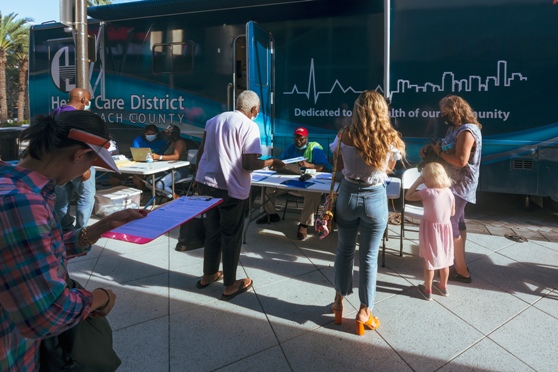US surpasses 40 million known coronavirus cases
By Daniel E. Slotnik and Adeel Hassan
WASHINGTON – More than 40 million cases of the coronavirus have been recorded in the United States, according to a New York Times database.
The total number of known infections, more than the population of California, the nation’s most populous state, is a testament to the spread of the coronavirus, especially lately the highly contagious Delta variant, and the United States’ patchwork efforts to rein it in.
Vaccines are effective in preventing severe disease and death, but 47% of Americans are not fully vaccinated, allowing the Delta variant more than enough opportunity to inflict suffering and disrupt daily life. Health officials say that most of the patients who are being hospitalized and dying are not vaccinated and that it is those unvaccinated people who are driving the current surge and burdening the health care system.
Over the past week, new virus cases have averaged more than 161,000 a day, as of Sunday (5). New deaths are up to 1,560 a day, and hospitalizations are averaging more than 102,000 a day. Those numbers, while very high, remain lower than last winter’s peaks.
Before July 4, President Joe Biden said he hoped for “a summer of freedom.” Instead, the delta variant became the dominant form of the virus, ravaging unvaccinated populations and filling intensive care units in some states.
In an appearance Sept. 1, Gov. Brad Little of Idaho, a Republican, pleaded with people to get vaccinated.
“I wish everyone could have seen what I saw in the ICU last night,” he said.
On Tuesday (7), Idaho’s Department of Health and Welfare said it has activated crisis standards of care, emergency measures put in place when there are insufficient health care resources available, in the northern part of the state. Hospitals will implement the standards as needed, according to a news release from the department.
“When crisis standards of care are in effect, people who need medical care may experience care that is different from what they expect,” the department said. “For example, patients admitted to the hospital may find that hospital beds are not available or are in repurposed rooms (such as a conference room).”
Dave Jeppesen, director of the department, said, “This is a decision I was fervently hoping to avoid.”
Gov. Jim Justice of West Virginia said at a news conference Monday that the virus had flooded many of his state’s hospitals and closed schools there.
“We’ve got a really big time, big time situation in West Virginia, as it is all across this nation,” said Justice, a Republican.
After reading a list of people who died in his state from causes related to the disease since Friday, Justice pleaded with the unvaccinated people of West Virginia to get inoculated.
“We’ve got to get vaccinated for all, not just for you but for everybody — we’ve got to do this,” he said. “We can stop a lot of this terrible, terrible, terrible carnage.”
No US state has more than 70% of its population fully vaccinated, according to federal data, and while the average pace of vaccinations ticked upward this summer, it remains far lower than when it peaked in the spring.
Cases in the United States make up nearly one-fifth of the known global total, more than 221 million cases as of Tuesday, according to data from the Centre for Systems Science and Engineering at Johns Hopkins University. That is likely to be an undercount because of factors like insufficient testing and reporting.
The news came at the end of the Labour Day holiday weekend, not long after Dr. Rochelle P. Walensky, director of the Centres for Disease Control and Prevention, warned that unvaccinated Americans should avoid travel.
But data from the Transportation Security Administration suggested people did not stay home in droves. TSA checkpoints recorded 2.13 million travellers through US airports Friday (3), close to the number on the Friday before Labour Day two years ago.
-New York Times


